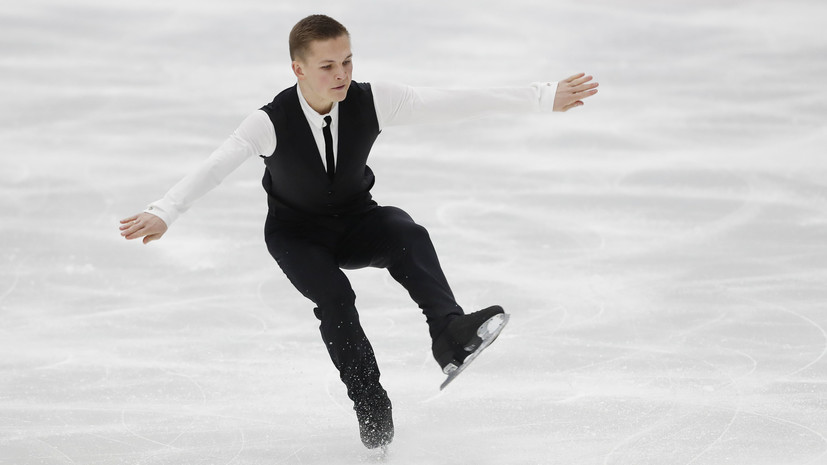First, a few numbers: the short men's program with the highest total of 92.39 points was completed by two athletes at once - Jason Brown and Canadian Keegan Messing. Mikhail Kolyada finished third, losing in technique to Messing, Brown, Dmitry Aliev and Nikolai Mayorov, who plays for Sweden, but traditionally high marks for components served as the float that kept the Russian leader among the best.
In an arbitrary box office, the trend continued: Kolyada finished second behind Matteo Rizzo (176.18), but in technique he was 6.87 worse than the Italian and almost ten - worse than Semenenko. At the same time, Rizzo did not do anything outstanding in his program: two quadruple sheepskin coats are about to begin to be considered a "women's" set in single skating. As for Brown, he did not bother with jumping in four turns at all: in order to beat Kolyada in the overall standings, he had enough breakaway in the short program with a triple flip, triple axel and triple lutz in a cascade with a sheepskin coat (a similar set of jumps, for example, performed by Elizaveta Tuktamysheva).
During the first tournaments of the season, it is customary to discuss to a greater extent not the quality of the elements, but the performances, but here, it seems to me, this is not the case, since no male performance can be considered good if the performer's jumps are lame. Brown with his triples does not count here: he is neither the leader of his country, nor even number two. The only US championship where the skater won was held almost seven years ago.
In other words, the likelihood that this athlete will be in the Olympic team tournament is extremely small. Kolyada is a completely different story. The assessment of the St. Petersburg athlete for the components in an arbitrary (86.84) eloquently testifies that it is him, and not Aliev (82.84) and not Semenenko (75.60), that the judges continue to consider the first Russian number. And the first number has no right to bring down the short one and jump "butterflies" in the free one. In this case, it becomes somewhat awkward to talk about the success of the performances. Although apart from jumps, Mikhail, of course, turned out to be successful this season.
A few days before the September open skates, Kolyada refused the short program "The Nutcracker" - the one that he presented in Espoo.
Then the skater explained the replacement by the fact that his coach Alexei Mishin “didn’t like something,” so the already done program was replaced by another one - “In Memory of Caruso”.
Then, apparently, something again seemed dubious to the mentor: Caruso was sent to the reserve, and he was replaced by The Nutcracker again.
The production turned out to be absolutely in Mishin's style: all the students of the great mentor passed through the classics of the ballet repertoire, epaulettes, aiguillettes and red and gold camisoles at different times.
It's just that such a theatrical performance in figure skating is the most difficult, since it obliges and requires from the skater not only perfection of movements, but above all the ideal implementation of all technical tasks.
This is especially true for the short program, in which, as already written above, an athlete of the Kolyada class must be able to work out the prescribed elements, as they say, with his eyes closed. According to it, the athlete is met, evaluated and remembered for many starts ahead. The free part is a completely different story: it can be rolled and honed right up to the main start without damaging the reputation.
25 years ago in figure skating there was already a period when male singles were overwhelmed by a total craving for the most vivid images on ice.
This happened after the Canadian Elvis Stoyko became the 1995 world champion.
The Canadian was never distinguished by great musicality and plasticity, but he jumped cool and very stable.
And for his programs he chose mainly characteristic images of warriors and discoverers.
When the rest of the athletes, much less confident in difficult jumps, began to “play in the image” following the example of the Canadian, the competition began to turn into a theater of absurdity, forcing one to recall the statement of the great Igor Moiseev that there is only one step from an image to an image.
And even then it was clear: theatricality on ice can be justified only when the sports part of the program does not cause any complaints.
In Espoo it came to mind again.
When Kolyada tore off the first quadruple jump in a short, and then the second, the magic of the performance immediately disintegrated.
Remained the image of a small, not too self-confident boy, who, standing on an impromptu stage of a fancy-dress party, desperately and unsuccessfully tries to remember the memorized text.
It was much easier for all the other skaters, including the winner, in this regard: hardly any of them in February can face the task of defending the fate of the gold team awards at the Olympic Games.

